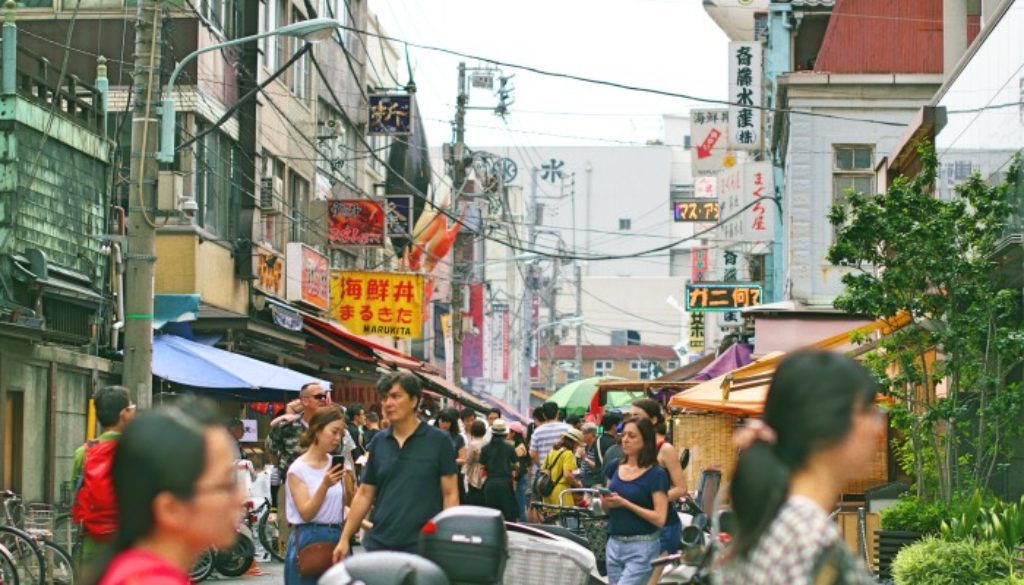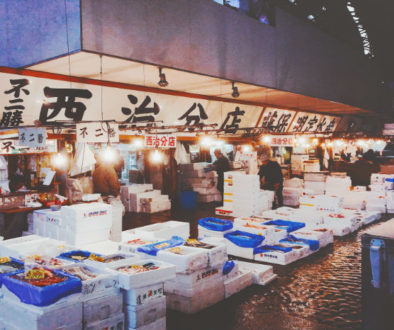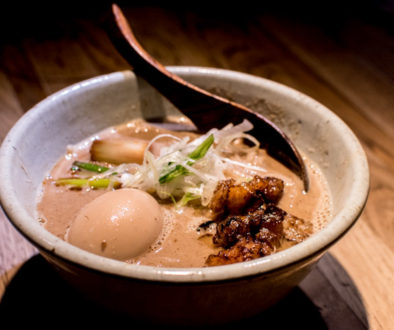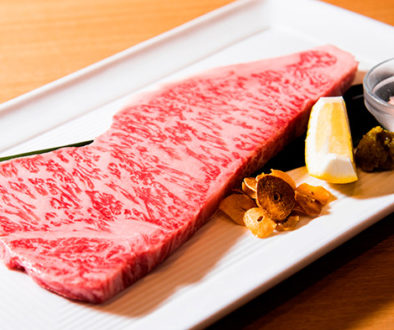Guide to Tokyo Street Food: Top 5 You Can’t Miss
Everybody loves street food. When it comes to Tokyo street food, you may be wondering why you don’t see as many food stands in Tokyo as you might see in other parts of Asia.
You are right–street foods are common mainly in local markets and seasonal festivals in Japan.
So what should you try in Tokyo if you are looking for some cheap eats?
I am a food tour guide at Ninja Food Tours and I spend a lot of time eating outside. I am not going to let you go home without trying these 5 foods.
Are you ready?
Here are some food ideas for you:
1. Wagyu Beef Croquette
People think that they have to pay a lot of money to try wagyu beef in Japan. Not true!
Try some beef croquette in Tokyo. It is a typical homemade dish of minced beef and pork meat, seasoning, and pepper. Also, add a lot of onions for a somewhat sweet flavor that goes well with juicy meat. After mixing everything, just deep fry it.
Price?
It only costs 200-300 yen per piece.
It is called “Menchi-Katsu” in Japanese. It literally means deep fried minced beef.
Usually wagyu beef is fatty and tender. Some might say that is the best part, but I personally cannot eat wagyu beef steak after my 3rd bite at a wagyu steak restaurant in Tokyo.
Of course, it is really expensive (No offense to those expensive Japanese cows).
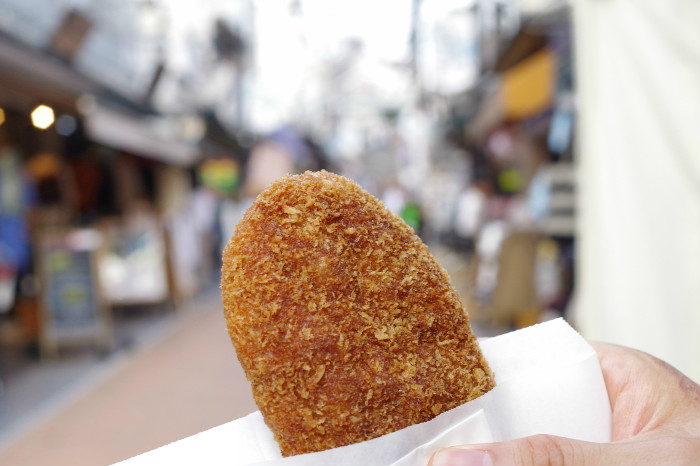
There are other types of croquettes and deep fried stuff that are commonly eaten in Tokyo:
- Japanese croquette with potato and meat
- White sauce and crab meat croquette
- Curry flavored croquette
- Tonkatsu: pork cutlet
The best way to eat?
Add some Tonkatsu or oyster sauce to those croquettes and eat it with rice.
Tokyo Street Food Guide: where to go for croquettes
- Asakusa Menchi (Asakusa): Their Menchi-Katsu is only 200 JPY. A high-quality brand of pork (like Kobe for beef) and good quality beef are mixed together with simple seasonings. Ask for mustard if you would like. A nice snack when you go explore Asakusa.
- Ooyama (Ueno / Okachimachi): Also 200 JPY for a very tasty minced beef croquette. They have a standing bar area that serves drinks. Order some other dishes with maybe a beer. Great way to take a break from a long walk through Tokyo. This restaurant is located in Ameyoko, a local market street in Ueno. Visit Ueno Park and Ueno Zoo if you have time afterward.
Do you not like deep fried stuff?
Let’s move on to the next one then.
2. Takoyaki
Takoyaki is one of the traditional snacks in Japan. It is cooked in a ball-shaped hot plate after mixing flour with soup stock, and then octopus and other ingredients are added while cooking. A good Takoyaki is very crispy outside and creamy inside.
From Osaka
It is originally from the Kansai area (e.g. Osaka) and now it is commonly eaten across Japan. There is even a term for Takoyaki parties, “Takopa” in Japanese. Takopa is a good way to hang out with friends making Takoyaki. It is easy to cook with simple ingredients if you have a Takoyaki cooking tool.
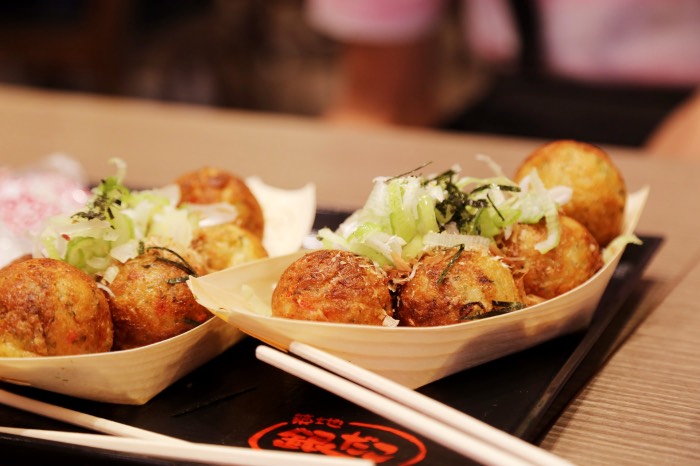
It’s not just about octopus
Do you think it is just octopus balls? Do not underestimate Takoyaki.
There are variations in cooking styles and ingredients based on the region. Also, many restaurants specialize in Takoyaki.
Tokyo Street Food Guide: where to go for Takoyaki
- Fukuyoshi (Ginza): Fukuyoshi serves authentic Osaka-style Takoyaki dishes. One serving is just 500 JPY for 8 pieces of Takoyaki. You can also add toppings (e.g. scallions/spring onions, mayo, and cheese etc). My favorite is the Negi Pon, Takoyaki with citrus-based Ponzu sauce and scallions.
- 8864 (Shinbashi): Do you know what goes well with Takoyaki? Beer! This cozy tapas style restaurant serves good Japanese street foods including good Takoyaki. The best part of 8864 is that everything they serve is tasty. They also serve wine and other types of drinks as well. The restaurant is in a business district and closed on Sundays and holidays.
By the way, be sure not to burn yourself when you try Takoyaki. It is very hot when it gets picked up from the pan!
3. Yakisoba
Everyone likes noodles, don’t they?
Traditional home cooking in Japan
You only know ramen and soba noodles and you have not heard of yakisoba? It is a Japanese stir-fried noodle dish. Yakisoba became popular after the war to serve hungry people as a cheap carb dish. Back then a lot of cabbage and oyster sauce were added to make the dish portion bigger. Now it is one of the popular home-cooking dishes in Japan. Moms have their own recipes … or “special ingredients” A.K.A. leftovers from last night.
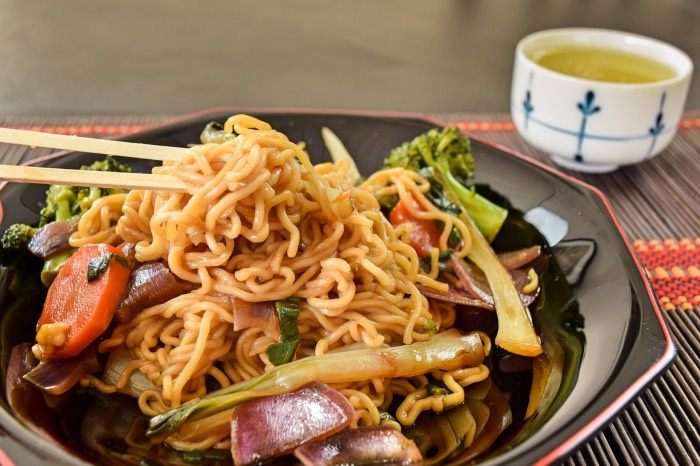
Try regional Yakisobas
What is interesting about these street foods in Japan is regional variations. You should definitely try these regional Yakisobas when you travel to outside of Tokyo. The following are just some of the many types, and not even close to a comprehensive list:
- Hokkaido: Kitami Shio Yakisoba
- Akita: Yokote Yakisoba
- Miyagi: Ishimaki Yakisoba
- Shizuoka: Fujinomiya Yakisoba
- Okayama: Hiruzen Yakisoba
Differences among these? You should try and let me know.
Tokyo Cheap Eats: Where to go for Yakisoba
- Mikasa (Takadanobaba, Jinbocho, and Jiyugaoka): So, unfortunately, not a lot of restaurants specialize in Yakisoba. Being a typical home-cooked dish, maybe people do not see a big value to get Yakisoba outside. Mikasa is out to prove them wrong. The restaurant only serves Yakisoba for 800 JPY and they usually run of out noodles by the early evening on weekends. Their homemade noodle really goes well with beer as well. Sitting right in front of the kitchen makes you really hungry, so be prepared.
- Kabukichi (Shinjuku): Kabukichi is located in the middle of Tokyo’s neon town, Kabukicho in Shinjuku, and is open 24/7. This restaurant is not even close to those chain restaurants you see in Shinjuku. You will taste authentic Yakisoba with an egg for 700 JPY. Great flavor from the oyster sauce and ingredients. After 6-7pm, you might see business men drinking beer with their Yakisoba.
4. Mochi sweets
Now we get to the fun part. Sweets.
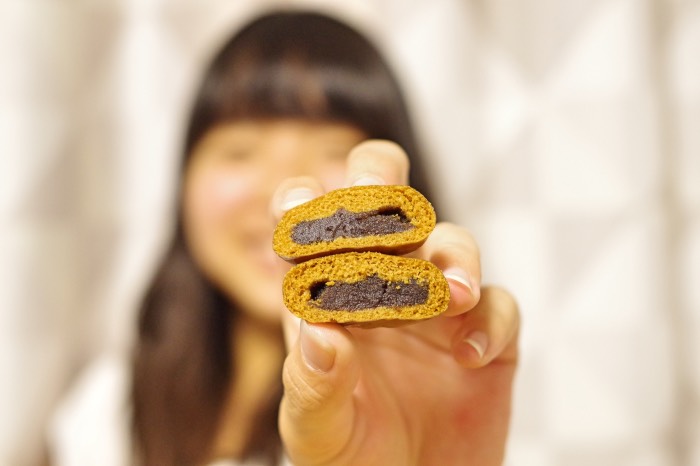
Mochi is basically a rice cake, and sweet stuffing is usually filled inside of the mochi. The stuffing can be sweet red beans, custard, ice cream, or even tiramisu. Sometimes a fresh strawberry is added on top of or inside of the mochi (Strawberry mochi).
Sweet mochi is very common, so even though it is not technically a street food, I have included this on this list. You will find sweet mochi everywhere across Japan.
Typically sugar is added to the mochi to keep it soft, otherwise the mochi gets tough. Have you ever encountered a tough piece when you try to eat the mochi that you bought a week ago? Eat it fresh.
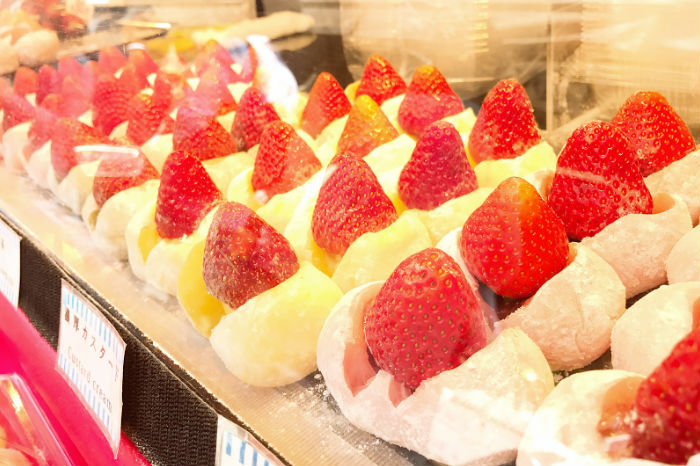
Tokyo Street Sweets Guide: Where to go for Mochi Sweets
- Mame (Aoyama): This store gained popularity since it opened in 2015 near Omotesando. My favorite is the Strawberry mochi in Spring. They select a great strawberry brand, Amao, from the Kyushu region, south of Japan. The juicy and flavorful strawberry perfectly matches with smooth sweet red beans and mochi. Their strawberry mochi costs 330 JPY per piece. You will find different types of seasonal sweets depending on when you go there. Do you not recognize anything that you see in the store? Worth giving it a try.
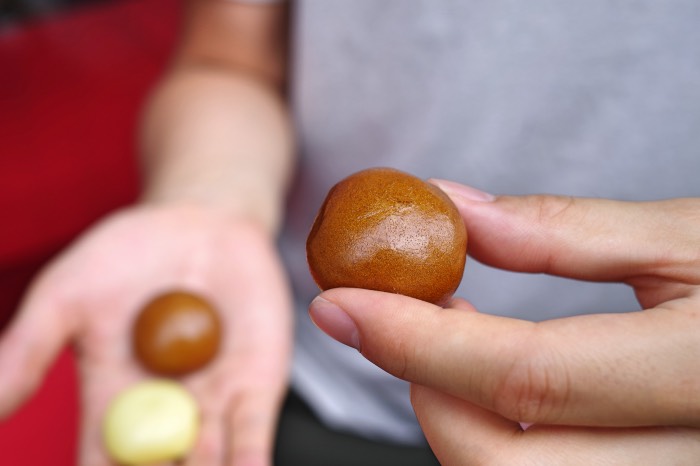
- Asadaya (Tameike Sanno): True hidden gem near Akasaka. You will never find this place unless you know where to go. Their mochi is relatively thicker compared to other places but the balance between the mochi and filling is just perfect. Try their bean mochi. The salty flavor from the beans outside goes surprisingly well with the sweet red beans. You would probably not be able to find this outside of Japan.
5. Beef Tripe Stew
We are not done yet! I’ve got one last thing.
You may be wondering why the heck you have to try beef tripe when you are on vacation.
Please do not go home without trying tripe–get a good one though.
It is worth a try.
I have seen many people on my food tours trying beef tripe for the first time, and they actually liked it.
Tripe by itself is actually pretty much tasteless. It may be smelly if it is not fresh or prepared appropriately.
It is served in a salty miso flavored stew with seasonable vegetables. The key is miso (fermented soy bean paste) as it gives a lot of nice flavor to the stew along with the vegetables. People even add the tripe stew over rice and eat it for lunch.
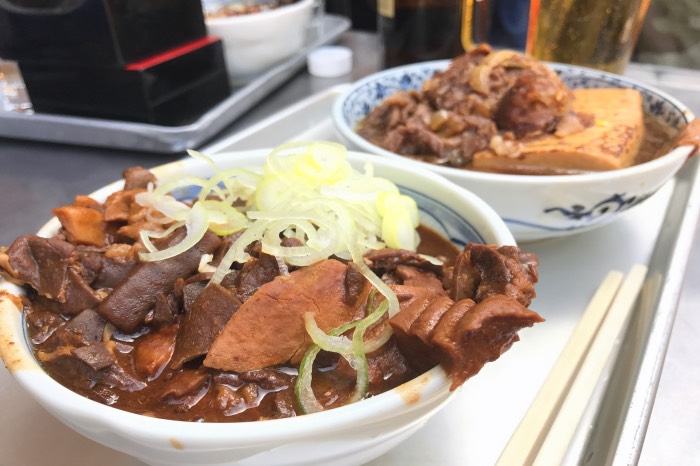
Tokyo Street Food Guide: Where to go for beef tripe stew
- Numata (Shinjuku 3 Chome): In a busy business district in Shinjuku, Numata is a popular Izakaya style restaurant that serves good quality of tripe dishes. My favorite is the spicy miso tripe stew. Perfectly seasoned, and it goes well with any type of drink. Expect to wait for a while during peak hours (7pm – 1opm).
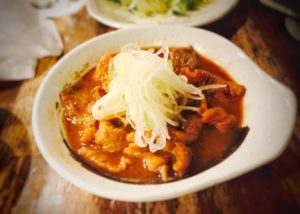
- Osakaya (Monzen Nakacho): Osakaya’s tripe stew is relatively thicker and richer compared to other places in Tokyo. There are only 13-14 seats inside surrounding the stew pot in the restaurant. Another hidden gem if you like to try a good stew. It is worth making a trip to Monzen Nakacho. No pictures allowed inside. You will have a true local culinary experience if you make it to Osakaya.
Are you hungry yet?
I’d like to hear from you!
Whether you have a question or a comment, let me know what you think.

